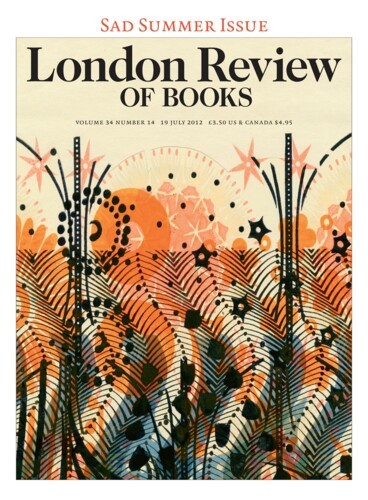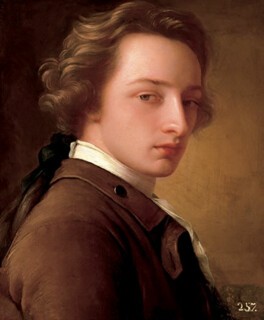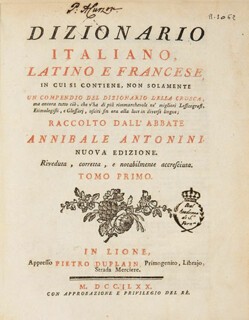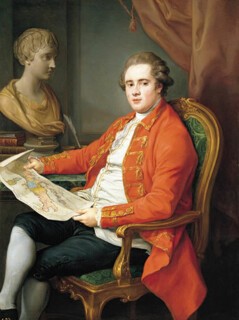At noon on 7 January 1779 the British merchant ship Westmorland, en route from Livorno to England, was captured by two French warships off the Spanish coast. France having joined the War of Independence on the side of the Americans, the Westmorland’s captain, Willis Machell, was prepared for trouble. He had a crew of sixty and 22 cannons, but was outgunned. The ship was towed into Málaga and declared a legal trophy of war, whereupon the French set about selling the cargo while the crew and passengers were taken as prisoners to Cádiz and in due course exchanged and sent home. It was a civilised business for the most part, no more than a footnote in the history of the war.
In the history of Georgian polite culture, however, the capture of the Westmorland has come to be seen as a uniquely important event. The reasons for this are set out in an imaginative, subtle exhibition (until 27 August) that reunites more than 120 of the eight hundred or so items known to have been on board. The result is a precise historic moment caught in cross-section and an implicit commentary on the nature and scope of art-historical inquiry.
Much of Captain Machell’s cargo consisted of the luggage of travellers who were either still on the Grand Tour or had recently returned home. They had for the most part followed a well-worn route that led through France into Italy, including an extended stay in Rome, and they journeyed in pursuit of many things including but by no means limited to erudition and social polish. Their owners had consigned to the Westmorland a variety of objects: prints and paintings, guidebooks, marbles, architectural designs, fans, lumps of Vesuvian lava, sheet music, a copy of Tristram Shandy, as well as wheels of Parmesan and several barrels of anchovies. The trivial and the perishable were packed in among the treasures, and in the scholarly unpacking that has made the exhibition possible, the uneven reality of the Grand Tour is captured at the point when it had reached its fashionable peak, but passed its heyday as a hunting ground for major antiquities and old master paintings.
It follows that there are no great works of classical art on show. The only important antiquities on the Westmorland are now lost, a pair of priapic marble fauns belonging to the collector Charles Townley. In their catalogue essay Jonathan Yarker and Clare Hornsby follow Townley’s attempts to retrieve his property and the unhappy fate of the fauns who were last seen in Madrid a few years later, so drastically modified that they were listed as bacchantes.* By the 1770s the Italians had instigated a system of export licences that prevented visitors from carrying off antiquities. There was, however, what Yarker and Hornsby characterise as ‘a highly structured marketplace’ in which dealers, diplomats, artists, many of them English, and fixers of all sorts catered for the tourists.
The most important fixer was Thomas Jenkins, who began as a dealer, became a banker and ended up as de facto British consul in Rome. His name is everywhere in the exhibition, one of the largely forgotten figures whose importance it recovers. Elsewhere the story is in parts familiar. There are the young bloods, Francis Basset and George Legge, Viscount Lewisham, sitting in scarlet coats to Pompeo Batoni, whose portraits by this stage were so formulaic that their subjects might as well have stuck their heads through a hole in a pre-painted background. But as John Brewer emphasises in his catalogue essay, the Tour was more socially mixed than it might appear. Basset, the biggest spender among the consigners to the Westmorland, was not an aristocrat but the beneficiary of a recent family fortune made from Cornish mines.
By now the Tour was also less of an exclusively male rite of passage. This second generation of tourists often went later in life and took their wives with them. Nor was the cartoon image of the accompanying tutor as a put-upon bear-leader struggling to get his charge to learn more and drink less, the whole truth. David Stevenson and William Sandys, tutors to Lewisham and Basset, emerge as significant characters with important contacts and interests of their own. Piranesi dedicated a print to Sandys while Stevenson is depicted with Lewisham among the crowd of cognoscenti admiring works of art in Zoffany’s painting of 1772-77, The Tribuna of the Uffizi, a picture in which the nudity of the statues and the dubious character of some of the sitters gave rise to gossip throughout the five years it took to complete. In her catalogue essay María Dolores Sánchez-Jáuregui suggests that the pair depicted standing nearby may be Sandys and Basset. Although her evidence is slight, if true the identification would have implications she does not discuss, since both pairs are placed in the groups that Zoffany depicts via some hefty nudges as homosexual.
The presence of the ‘finger-twirlers’ as Hester Thrale called them was one reason George III, who had commissioned the picture, was reluctant to accept it and later hung it out of the way at Kew. But they were a noticeable set among the tourists. The portrait in Crate J.H. of a broodingly handsome but unknown young man belonged to a Scottish landowner called John Henderson; a friend of Henderson’s made a poignant though unsuccessful plea for its return on the basis that it was a ‘portrait which he joys’, and was of no intrinsic value to anyone else. The Grand Tour offered a refuge from sexual convention. The crates on the Westmorland marked H.R.H.D.G. and containing an elaborate marble chimneypiece and a set of paintings, have been found to belong to the king’s brother, the Duke of Gloucester, who had retreated to Italy in disgrace after his marriage to the illegitimate Maria Waldegrave became known.
Within its historic moment, the exhibition also catches an aesthetic in flight. Somewhere in transit from Italy to England, the taste for the classical was transformed into the neoclassical. The designs, fabrications and modern copies of busts and urns carried home from the Grand Tour took their place in landscape gardens and Adamesque interiors. Like the hairline join on the nose of a marble head, possibly reworked from a Roman original and found in Crate L (owner unknown), one taste dovetailed into another. Six watercolours of the Alban Hills, commissioned by Basset from John Robert Cozens, with their delicate shadows and elegiac evocations of scenes associated with Virgil and Ovid, represent the Arcadia of the Romantics, to be translated on landed estates into the English Picturesque.
In the event Basset had to landscape his grounds at Tehidy Park in Cornwall without his watercolours and the contents of the Westmorland were dispersed. A painting commissioned by Sir Watkin Williams Wynn, Mengs’s Liberation of Andromeda by Perseus, was the single most valuable item on board. It passed, eventually, into the collection of Catherine the Great and remains in the Hermitage. A large proportion of the rest was bought by Carlos III of Spain for the new Real Academia in Madrid. When it arrived the librarian carefully marked the books ‘P.Y.’ for ‘Presa Ynglesa’ or ‘English Prize’, initials whose meaning faded over time and was lost until 1999, when Spanish scholars, working on the history of museums, uncovered it. The process of historical and actual reassembly of the cargo still continues and as it goes on the picture that emerges becomes more detailed, the whole ever greater than the sum of the parts.
The newest discovery, made as the catalogue was going to press, was a group of saint’s relics, a gift from Pope Clement XIV to the Catholic recusants, the Arundells of Wardour Castle in Wiltshire. Earlier in its history the Grand Tour had been associated with Catholic dissent and the Stuart court in exile in Rome. By the 1770s such subversive overtones were largely gone, but Catholic worship was still illegal in England and to evade inquisitive Protestant excise men, the relics were concealed in a block of marble. Their existence was known only from the correspondence of a former Jesuit, Father John Thorpe, who had supervised the operation and wrote anxiously after the ship’s capture to try and retrieve his sacred commission.
In Catholic Spain it was understood that relics were not spoils of war and could not be sold. Eventually they made their way to England and were rediscovered recently, where they were always intended to be, in the chapel at Wardour. As well as adding to the story of the Westmorland their reappearance emphasises the value of a scholarly enterprise which has ‘found’ so much that was never lost but merely awaited intelligent interpretation.
Send Letters To:
The Editor
London Review of Books,
28 Little Russell Street
London, WC1A 2HN
letters@lrb.co.uk
Please include name, address, and a telephone number.




